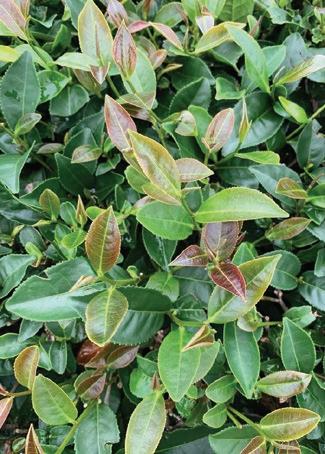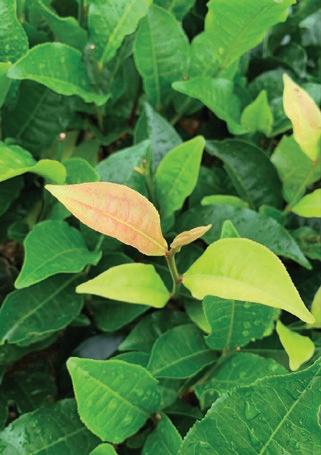
5 minute read
Origin Spotlight : Taiwan
O R I G I N S P O T L I G H T
TAIWAN
Advertisement
Taiwan has a fascinating history of tea cultivation and is among the most prestigious tea origins in the world today. Tea farming in Taiwan originated in the 17th century with the arrival of tea plants and artisanal production methods from Fujian. Taiwan played a key role in the early days of the international tea trade as a producer and shipping hub for Portuguese, Dutch and English merchants. In fact, some Taiwanese teas are marketed with the Portuguese name Formosa, meaning “beautiful isle.” In the early 20th century, during Japan’s occupation of Taiwan, the Japanese brought new ideas in tea cultivation practices and processing technologies that left an imprint still seen today. A deep understanding of Taiwanese tea requires the consideration of both cultivar and terroir. From the mid 20th century, the Taiwan Tea Research Extension Station has managed a tea cultivar breeding program in an effort to create new tea varieties that express unique and marketable flavors and aromatics. Most tea grown commercially in Taiwan today is made from this list of just over 20 prized tea cultivars that have been promoted for those benefits. Qingxin “Pure Heart” is prominent for Taiwan’s famous High Mountain Oolong teas. Jinxuan “Golden Lily” (#12), Hong Yu “Ruby” (#18) and Hong Yun “Red Charm” (#21) are some examples you can find in Rishi’s Garden Direct collection.


TOP: Terroir and elevation are critical in understanding Taiwanese tea.
ABOVE: Tea farmers plant specific cultivars at higher elevation that have been selectively bred over the years to adapt to such a dynamic growing environment. Terroir and elevation are critical in understanding Taiwanese tea. Tea cultivation is segmented into three elevation zones in Taiwan: low (below 500m), medium (500-999m) and high (1,000m+). Low and medium elevation gardens are characterized by generally warmer and more consistent temperatures. They are more forested and less likely to be buffeted by strong typhoon winds and dynamic weather compared to higher elevations. The teas that thrive in these regions include Iron Goddess of Mercy, Four Seasons Spring and Eastern Beauty – all unique types of oolong tea.
High elevation gardens are more directly exposed to intense UV rays from the Sun, as well as more dynamic weather features like periods of dense fog and a greater swing in daytime and nighttime temperatures. These elements coincide to act as stressors on the tea plants and in turn influence flavor. Just as wine grapes grown in difficult environments produce some of the most sought-after wines, high mountain tea plants yield a greater range of complex aromatic molecules than lower elevation teas.
Tea farmers plant specific cultivars at higher elevation that have been selectively bred over the years to adapt to such a dynamic growing environment. Teas grown at 1,000m+ in elevation are denoted as gao shan cha, or “high mountain tea,” and are some of the most cherished in the world by tea connoisseurs. The dense cloud cover reduces the intensity of UV exposure and triggers the tea bushes to photosynthesize and produce more amino acids. This natural plant struggle is often mimicked with specialized shades in Japanese high mountain tea production to obtain elegant tannin and fresh aromatics.
Extensive scientific research and a nuanced understanding of how cultivar and terroir influence flavor development has made Taiwan a tea origin of the highest renown. As you explore our Garden Direct offerings from Taiwan take note as to how cultivar, harvest date, elevation and geography all connect to transform flavor.



ABOVE: The dense cloud cover reduces the intensity of UV exposure and triggers the tea bushes to photosynthesize and produce more amino acids.
LEFT: From the mid 20th century, the Taiwan Tea Research Extension Station has managed a tea cultivar breeding program in an effort to create new tea varieties.


EARL GREEN FOUR SEASONS SPRING
EG-OP ORIGIN: RISHI HERB LAB Ingredients: Oolong tea, essential bergamot oil.
Earl Green is our oolong version of the black tea classic Earl Grey. This original blend highlights the alluring lilac fragrance of Bao Zhong oolong tea, which harmonizes gorgeously with citrusy and floral essence of bergamot. Earl Green is an oolong tea for all seasons and makes a remarkably delicious and easy-drinking cold brewed tea.
JO-OP ORIGIN: NANTOU, TAIWAN Ingredients: Oolong tea.
Four Seasons Spring is a lightly oxidized, ball rolled oolong tea that is harvested twice each year in Taiwan’s central highlands. Made from the Si Ji Chun cultivar of the same name, Four Seasons Spring has a golden-green, medium bodied infusion with a very floral, long-lasting aromatic complexity evocative of fresh gardenia, freesia blossoms and tropical fruit. It is grown at elevations of 500-850 meters above sea level in the Mingjian Village of Nantou, Taiwan.
RUBY OOLONG
ORO250-RP ORIGIN: DOI MAE SALONG, THAILAND Ingredients: Organic oolong tea.
Ruby Oolong is a special type of oolong tea produced in the mountainous Doi Mae Salong region in northern Thailand. This full-bodied oolong tea is deeply oxidized and slowly baked to bring out complex layers of cacao, raisins, and black cherry with a sublime, elegant structure. The soil in northern Thailand is soft and loamy, providing a concentration of nutrients not found in other oolong tea origins. This lends a unique sweetness and rich viscosity in mouthfeel.
Ruby Oolong is an excellent introduction to the world of oolong tea with its deliciously sweet caramelized fruit and chocolate aromas that permeate the air as soon as it’s brewed.


TROPICAL COCONUT
TCOCOO-OP ORIGIN: RISHI HERB LAB Ingredients: Oolong tea, organic pineapple, organic coconut flakes, natural coconut flavor.
Tropical Coconut combines floral and delicately sweet Bao Zhong oolong tea with real juicy pineapple and creamy coconut. With its enticing tropical aroma, this tea is sure to turn tea novices onto the wonders of oolong tea.










